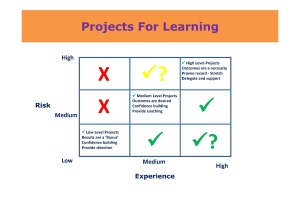A high performing team is one where the output or performance of the team at least equates to the output that you would expect from the collective talent of all the teams members. This statement is easy to say, but hard to achieve. In fact, 93% of my clients report that from a professional perspective they have never worked in a truly high performing team. They have worked in good teams, but not high performing ones.The Teams That Matter® model for creating high performing teams includes seven key elements. Most teams naturally do three or four of the seven elements. But it is the three or four that they aren’t doing that stops them from being a high performing team. The main reason for not doing three to four of the key elements is that they don’t know about them and they haven’t seen them modelled in the past.
1. Decide
If you intend to create a high performing team, then you must make a conscious decision to become one. Why? The three to four elements of the Teams That Matter® model that you haven’t completed in the past will require some getting used to. Your team members won’t be used to them either. Having a conversation as a team about what you would look like if you were a high performing team will help your team to clarify exactly what this statement means for them. It will then act as a catalyst for you to complete all the seven key elements of the Teams That Matter® model.
2. Purpose and Goals
Why does your team exist? The answer to this question highlights the purpose for your team. Your goals reflect the specific outcomes that you are striving to achieve. Your goals should reflect your ‘purpose in action’. Have you even been in a team where you have discussed your team’s purpose?
What if you discover that your team doesn’t have a purpose? Well, thank everybody and close the team down. Clearly time spent with this team would be a waste of time and who wants to do that in this time poor world that we live in.
3. Skills and Composition
Most teams have completed an assessment of the experience and skills of the members of their team. No doubt you have done that too.
I bet you haven’t taken steps to better understand the personality profiles of the members of your team. Or if you have, you haven’t done it in a way that has enabled you to use that information to improve communication on a daily basis among team members.
I use the What Makes People Tick tool, not because it is the most scientific, but because it is a tool that participants can use on a day to day basis beyond the introductory workshop. I find that other tools are too complex and require you to become an expert on the tool for it to be useful. Most people are too busy being experts in their own field of work to also have to become an expert on a personality profiling tool!
The benefit of understanding how each of your team members ‘tick’, is that you can modify how you communicate to ensure that your message is being delivered effectively. Effective communication is essential if you wish to become a high performing team.
4. Agreed Behaviours
Do high performing teams accept or reject unacceptable behaviour? I understand the answer to this question is a ‘no brainer!’. Yet, are you and your team members clear about what behaviours are acceptable or not for your team? Or do you assume that ‘everyone knows how to behave properly’? I’m telling you, they don’t know! Which is why you and your team need to make those behaviours explicit. Three questions is all it takes (I’ll share them in another post).
5. Plan and Measure
This is one of the elements that most team do. Although be careful with your measurements. Russell Ackoff, Professor Emeritus at the Wharton Business School said,
“It’s better to do the right thing wrong, than the wrong thing right. If you do the wrong thing right you just get wronger and wronger.”
Make sure that your measurements are measuring the ‘right’ things.
6. Perform
This means that you ‘do’ all seven elements in the model. It also means that you never, ever forget that if your team changes only by one person, it is a brand new team. You need to quickly review all seven elements and make any necessary adjustments. This is a critical lesson that most teams don’t know exists.
7. Monitor and Review
No doubt you monitor your progress toward your goals. Do you monitor your agreed behaviours? It’s hard to do if you haven’t made them explicit! This key element works hand in glove with the Agreed Behaviours and Plan and Measure elements.
In addition, when you complete a milestone or achieve a goal, the following four After Action Review questions are very powerful.
What did we plan?
What actually happened?
What did we learn?
What will we do next time?
Now you know how to create a high performing team. Give it a go!
Gary Ryan enables talented professionals, their teams and organisations to move Beyond Being Good.





 No matter how much practice you did, if you maintained this type of self talk you will have created a self-fulfilling prophecy. Moments in to your presentation your mind will go blank. Then it will fill with the words, “See, I knew I wasn’t any good at presenting and now look at what has happened! My mind has gone blank and the senior management team now thinks that I am useless!“
No matter how much practice you did, if you maintained this type of self talk you will have created a self-fulfilling prophecy. Moments in to your presentation your mind will go blank. Then it will fill with the words, “See, I knew I wasn’t any good at presenting and now look at what has happened! My mind has gone blank and the senior management team now thinks that I am useless!“ However, self talk is not enough. It must be balanced with doing the right work and focus. The right work in this example relates to learning how to do an effective presentation and putting what you learn in to practice before you do your presentation to the senior management team. Focus refers to the skills and structure that support the action that you are taking. In this example your focus would relate to the core message that you want to convey, the key supporting arguments that you have for your message and the call to action that you want the senior management team to adopt.
However, self talk is not enough. It must be balanced with doing the right work and focus. The right work in this example relates to learning how to do an effective presentation and putting what you learn in to practice before you do your presentation to the senior management team. Focus refers to the skills and structure that support the action that you are taking. In this example your focus would relate to the core message that you want to convey, the key supporting arguments that you have for your message and the call to action that you want the senior management team to adopt.